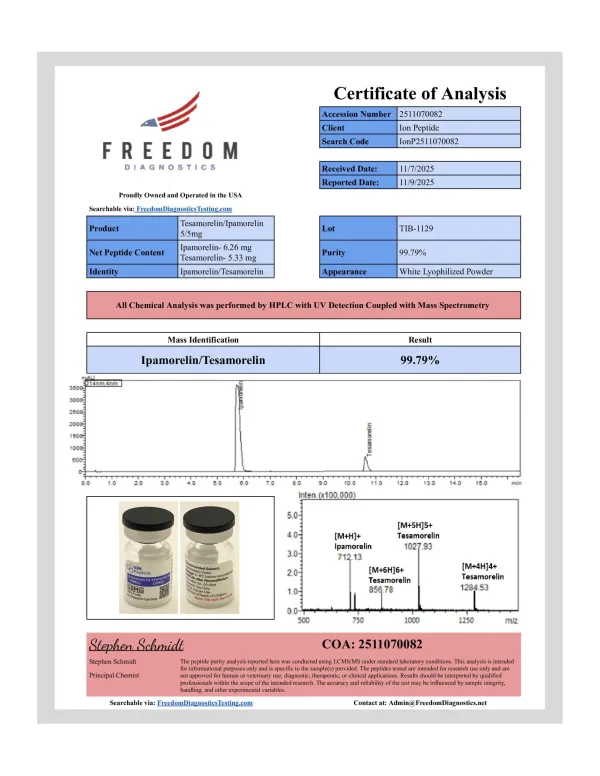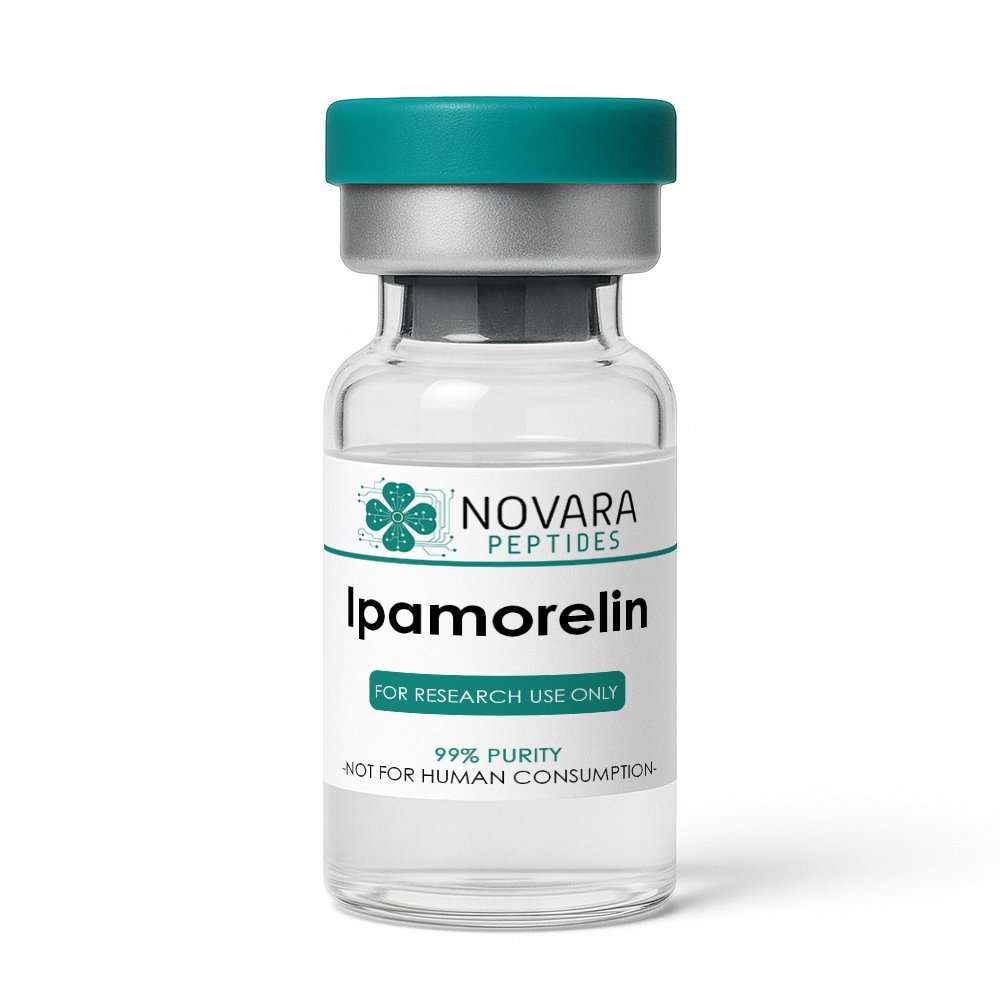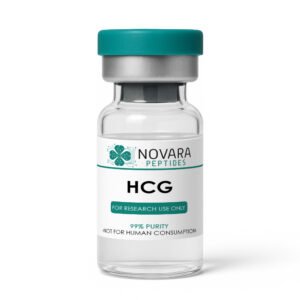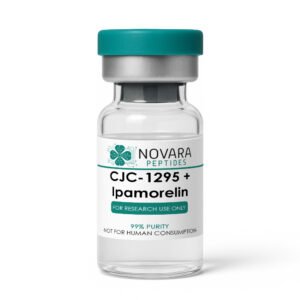Tesamorelin/Ipamorelin – 10mg
$ 69.95
All products are for laboratory research purposes only. Not for human consumption, medical, or veterinary use. ION Peptides does not condone or support the use of peptides outside of controlled scientific research. By purchasing, you acknowledge that you are a qualified researcher or institution. You must be 21 or older.




Tesamorelin/Ipamorelin (10 mg)
Research-Grade Growth Hormone Secretagogue Blend
Tagline: GH Axis & Metabolic Function Research Formula
Product Description
Tesamorelin/Ipamorelin is a dual peptide formulation combining two potent growth hormone–releasing compounds with complementary mechanisms of action.
Tesamorelin is a synthetic analog of Growth Hormone–Releasing Hormone (GHRH) that stimulates GH secretion via direct activation of GHRH receptors in the pituitary.
Ipamorelin is a selective growth hormone secretagogue (GHS) that activates ghrelin receptors (GHSR-1a), promoting GH release through a distinct signaling pathway.
Together, this combination provides a synergistic research model for studying growth hormone dynamics, IGF-1 regulation, fat metabolism, and muscle development.
For Laboratory and Scientific Research Use Only. Not for Human Consumption.
Why Researchers Choose Tesamorelin/Ipamorelin
Dual Pathway GH Stimulation: Combines GHRH and GHS receptor activation for enhanced GH release.
Metabolic Function Studies: Used in models of adipose metabolism, IGF-1 signaling, and energy balance.
Anabolic & Regenerative Research: Investigated for tissue repair, muscle growth, and cellular recovery.
Improved Lipid Mobilization: Tesamorelin supports visceral fat reduction and lipid oxidation pathways.
High Purity & Stability: ≥98% peptide purity verified via HPLC and MS analysis.
Important Note
For laboratory and scientific research only. Not for human consumption, therapeutic, or diagnostic use.
| Compound Name | Tesamorelin/Ipamorelin (Dual Peptide Complex) |
| Chemical Class | Growth Hormone Secretagogue & GHRH Analog |
| Chemical Formula (Tesamorelin) | C221H366N72O67S |
| Chemical Formula (Ipamorelin) | C38H49N9O5 |
| Molecular Mass (Combined) | ~5135 Da |
| Form | Lyophilized peptide powder |
| Storage Conditions | –20 °C (dry), 2–8 °C (after reconstitution) |
| Intended Research Use | Growth hormone, IGF-1, metabolism, and regenerative studies |
Research Applications
Growth Hormone Secretion & Endocrine Regulation
The Tesamorelin/Ipamorelin combination has been shown to synergistically elevate GH secretion by stimulating both GHRH and GHS receptors, creating a potent dual activation of the somatotropic axis [Bowers 2001].
Metabolic & Lipolytic Research
Tesamorelin increases lipolysis and fatty acid oxidation, reducing visceral adipose tissue while maintaining lean mass in metabolic disorder models [Falutz 2010]. Ipamorelin complements this by enhancing GH pulsatility without affecting cortisol or prolactin levels [Raun 1998].
Muscle & Tissue Regeneration
Through GH/IGF-1 signaling activation, this dual blend promotes protein synthesis, muscle regeneration, and recovery, serving as a research model for cellular growth and differentiation studies [Veldhuis 2005].
Neuroprotective & Mitochondrial Studies
GH and IGF-1 have demonstrated neuroprotective and mitochondrial support roles, suggesting potential utility for investigating neurodegenerative and aging-related processes [Frohman 2000].
References
Bowers CY. (2001). Growth Hormone Secretagogues: Basic Principles and Clinical Implications. Endocrine Reviews.
https://academic.oup.com/edrv/article/22/6/723/2425349Falutz J, et al. (2010). Tesamorelin, a Growth Hormone–Releasing Factor Analog, Reduces Visceral Fat in HIV-Associated Lipodystrophy. New England Journal of Medicine.
https://www.nejm.org/doi/full/10.1056/NEJMoa0905958Raun K, et al. (1998). Ipamorelin, the first selective growth hormone secretagogue. European Journal of Endocrinology.
https://eje.bioscientifica.com/view/journals/eje/139/5/569.xmlVeldhuis JD, et al. (2005). Mechanisms of Growth Hormone Secretion in Health and Disease. Endocrine Reviews.
https://academic.oup.com/edrv/article/26/6/753/2355337Frohman LA, et al. (2000). Regulation of Growth Hormone Secretion. Physiological Reviews.
https://journals.physiology.org/doi/full/10.1152/physrev.2000.80.2.681
Mechanism of Action
GHRH Receptor Activation (Tesamorelin): Stimulates pituitary somatotrophs via cAMP/PKA pathways to release GH [Falutz 2010].
Ghrelin Receptor (GHSR-1a) Activation (Ipamorelin): Binds to ghrelin receptors, enhancing GH pulsatility through calcium-dependent pathways [Raun 1998].
Synergistic GH Release: Dual stimulation increases both amplitude and frequency of GH pulses [Bowers 2001].
IGF-1 Upregulation: Elevated GH leads to hepatic IGF-1 production, driving anabolic and metabolic effects [Veldhuis 2005].
Lipid & Glucose Regulation: Modulates adipocyte metabolism and improves insulin sensitivity [Falutz 2010].
References
Bowers CY. (2001). Growth Hormone Secretagogues: Basic Principles and Clinical Implications. Endocrine Reviews.
https://academic.oup.com/edrv/article/22/6/723/2425349Falutz J, et al. (2010). Tesamorelin, a Growth Hormone–Releasing Factor Analog, Reduces Visceral Fat in HIV-Associated Lipodystrophy. New England Journal of Medicine.
https://www.nejm.org/doi/full/10.1056/NEJMoa0905958Raun K, et al. (1998). Ipamorelin, the first selective growth hormone secretagogue. European Journal of Endocrinology.
https://eje.bioscientifica.com/view/journals/eje/139/5/569.xmlVeldhuis JD, et al. (2005). Mechanisms of Growth Hormone Secretion in Health and Disease. Endocrine Reviews.
https://academic.oup.com/edrv/article/26/6/753/2355337Frohman LA, et al. (2000). Regulation of Growth Hormone Secretion. Physiological Reviews.
https://journals.physiology.org/doi/full/10.1152/physrev.2000.80.2.681







